A Novel Strategy to Enhance the Photostability of InP/ZnSe/ZnS Quantum Dots with Zr Doping
Abstract
1. Introduction
2. Materials and Methods
2.1. Chemicals
2.2. Preparation of TOP-Se and TOP-S
2.3. Synthesis of InP Core QDs
2.4. Synthesis of InP/ZnSe QDs
2.5. Synthesis of Different Kinds of InP/ZnSe/ZnS QDs
2.6. Purification of InP/ZnSe/ZnS QDs
2.7. Characterization
2.8. Photostability Test
3. Results and Discussion
4. Conclusions
Supplementary Materials
Author Contributions
Funding
Data Availability Statement
Conflicts of Interest
References
- Alivisatos, A.P. Semiconductor clusters, nanocrystals, and quantum dots. Science 1996, 271, 933–937. [Google Scholar] [CrossRef]
- Reiss, P.; Protiere, M.; Li, L. Core/shell semiconductor nanocrystals. Small 2009, 5, 154–168. [Google Scholar] [CrossRef] [PubMed]
- Brus, L.E. Electron-electron and electron-hole interactions in small semiconductor crystallites: The size dependence of the lowest excited electronic state. J. Chem. Phys. 1984, 80, 4403–4409. [Google Scholar] [CrossRef]
- Dai, X.; Zhang, Z.; Jin, Y.; Niu, Y.; Cao, H.; Liang, X.; Chen, L.; Wang, J.; Peng, X. Solution-processed, high-performance light-emitting diodes based on quantum dots. Nature 2014, 515, 96–99. [Google Scholar] [CrossRef] [PubMed]
- Michalet, X.; Pinaud, F.F.; Bentolila, L.A.; Tsay, J.M.; Doose, S.; Li, J.J.; Sundaresan, G.; Wu, A.M. Quantum dots for live cells, in vivo imaging, and diagnostics. Science 2005, 307, 538–544. [Google Scholar] [CrossRef] [PubMed]
- Michler, P.; Kiraz, A.; Becher, C.; Schoenfeld, W.V.; Petroff, P.M.; Zhang, L.D.; Hu, E.; Imamoglu, A. A quantum dot single-photon turnstile device. Science 2000, 290, 2282–2285. [Google Scholar] [CrossRef] [PubMed]
- Loef, R.; Houtepen, A.J.; Talgorn, E.; Schoonman, J.; Goossens, A. Study of electronic defects in CdSe quantum dots and their involvement in quantum dot solar cells. Nano Lett. 2009, 9, 856–859. [Google Scholar] [CrossRef] [PubMed]
- Schooss, D.; Mews, A.; Eychmüller, A.; Weller, H. Quantum-Dot quantum well CdS/HgS/CdS: Theory and experiment. Phys. Rev. B Condens. Matter 1994, 49, 17072. [Google Scholar] [CrossRef]
- Gattás-Asfura, K.; Leblanc, R.M. Peptide-Coated CdS Quantum Dots for the Optical Detection of Copper(II) and Silver(I). Chem. Commun. 2003, 21, 2684–2685. [Google Scholar] [CrossRef]
- Dabbousi, B.O.; Rodriguez-Viejo, J.; Mikulec, F.V.; Heine, J.R.; Mattoussi, H.; Ober, R.; Jensen, K.F.; Bawendi, M.G. (CdSe)ZnS Core-Shell Quantum Dots: Synthesis and Characterization of a Size Series of Highly Luminescent Nanocrystallites. J. Phys. Chem. B 1997, 101, 9463–9475. [Google Scholar] [CrossRef]
- Li, Z.; Yao, W.; Kong, L.; Zhao, Y.; Li, L. General method for the synthesis of ultrastable core/shell quantum dots by aluminum doping. J. Am. Chem. Soc. 2015, 137, 12430–12433. [Google Scholar] [CrossRef] [PubMed]
- Ellingson, R.J.; Beard, M.C.; Johnson, J.C.; Yu, P.; Micic, O.I.; Nozik, A.J.; Shabaev, A.; Efros, A.L. Highly efficient multiple exciton generation in colloidal PbSe and PbS quantum dots. Nano Lett. 2005, 5, 865–871. [Google Scholar] [CrossRef] [PubMed]
- Lim, J.; Park, M.; Bae, W.K.; Lee, D.; Lee, S.; Lee, C.; Char, K. Highly efficient cadmium-free quantum dot light-emitting diodes enabled by the direct formation of excitons within InP@ZnSeS quantum dots. ACS Nano 2013, 7, 9019–9026. [Google Scholar] [CrossRef] [PubMed]
- Marşan, D.; Şengül, H.; Özdil, A.M.A. Comparative assessment of the phase transfer behaviour of InP/ZnS and CuInS/ZnS quantum dots and CdSe/ZnS quantum dots under varying environmental conditions. Environ. Sci. Nano 2019, 6, 879–891. [Google Scholar] [CrossRef]
- Yong, K.-T.; Ding, H.; Roy, I.; Law, W.-C.; Bergey, E.J.; Maitra, A.; Prasad, P.N. Imaging pancreatic cancer using bioconjugated InP quantum dots. ACS Nano 2009, 3, 502–510. [Google Scholar] [CrossRef]
- Tamang, S.; Lincheneau, C.; Hermans, Y.; Jeong, S.; Reiss, P. Chemistry of InP Nanocrystal Syntheses. Chem. Mater. 2016, 28, 2491–2506. [Google Scholar] [CrossRef]
- Heath, J.R.; Shiang, J.J. Covalency in semiconductor quantum dots. Chem. Soc. Rev. 1998, 27, 65–72. [Google Scholar] [CrossRef]
- Lim, J.; Bae, W.K.; Lee, D.; Nam, M.K.; Jung, J.; Lee, C.; Char, K.; Lee, S. InP@ZnSeS, core@composition gradient shell quantum dots with enhanced stability. Chem. Mater. 2011, 23, 4459–4463. [Google Scholar] [CrossRef]
- Kulakovich, O.; Gurinovich, L.; Li, H.; Ramanenka, A.; Trotsiuk, L.; Muravitskaya, A.; Wei, J.; Li, H. Photostability enhancement of InP/ZnSe/ZnSeS/ZnS quantum dots by plasmonic nanostructures. Nanotechnology 2020, 32, 035204. [Google Scholar] [CrossRef]
- Savchenko, S.; Vokhmintsev, A.; Weinstein, I. Activation energy distribution in thermal quenching of exciton and defect-related photoluminescence of InP/ZnS quantum dots. J. Lumin. 2022, 242, 118550. [Google Scholar] [CrossRef]
- Savchenko, S.S.; Weinstein, I.A. Inhomogeneous broadening of the exciton band in optical absorption spectra of InP/ZnS nanocrystals. Nanomaterials 2019, 9, 716. [Google Scholar] [CrossRef]
- Narayanaswamy, A.; Feiner, L.F.; Meijerink, A.; van der Zaag, P.J. The effect of temperature and dot size on the spectral properties of colloidal InP/ZnS core-shell quantum dots. ACS Nano 2009, 3, 2539–2546. [Google Scholar] [CrossRef] [PubMed]
- Xu, Y.; Lv, Y.; Wu, R.; Shen, H.; Yang, H.; Zhang, H.; Li, J.; Li, L.S. Preparation of Highly Stable and Photoluminescent Cadmium-Free InP/GaP/ZnS Core/Shell Quantum Dots and Application to Quantitative Immunoassay. Part. Part. Syst. Charact. 2020, 37, 1900441. [Google Scholar] [CrossRef]
- Kim, S.; Kim, T.; Kang, M.; Kwak, S.K.; Yoo, T.W.; Park, L.S.; Yang, I.; Hwang, S.; Lee, J.E.; Kim, S.K.; et al. Highly luminescent InP/GaP/ZnS nanocrystals and their application to white light-emitting diodes. J. Am. Chem. Soc. 2012, 134, 3804–3809. [Google Scholar] [CrossRef] [PubMed]
- Lo, S.S.; Mirkovic, T.; Chuang, C.-H.; Burda, C.; Scholes, G.D. Emergent properties resulting from type-II band alignment in semiconductor nanoheterostructures. Adv. Mater. 2011, 23, 180–197. [Google Scholar] [CrossRef] [PubMed]
- Li, Y.; Hou, X.; Dai, X.; Yao, Z.; Lv, L.; Jin, Y.; Peng, X. Stoichiometry-controlled InP-based quantum dots: Synthesis, photoluminescence, and electroluminescence. J. Am. Chem. Soc. 2019, 141, 6448–6452. [Google Scholar] [CrossRef] [PubMed]
- Kim, T.; Won, Y.-H.; Jang, E.; Kim, D. Negative Trion Auger recombination in highly luminescent InP/ZnSe/ZnS quantum dots. Nano Lett. 2021, 21, 2111–2116. [Google Scholar] [CrossRef]
- Rao, P.; Yao, W.; Li, Z.; Kong, L.; Zhang, W.; Li, L. Highly stable CuInS2@ZnS:Al core@shell quantum dots: The role of aluminum self-passivation. Chem. Commun. 2015, 51, 8757–8760. [Google Scholar] [CrossRef]
- Yan, L.; Li, Z.; Sun, M.; Shen, G.; Li, L. Stable and flexible CuInS2/ZnS: Al-TiO2 film for solar-light-driven photodegradation of soil fumigant. ACS Appl. Mater. Interfaces 2016, 8, 20048–20056. [Google Scholar] [CrossRef]
- Koh, S.; Lee, H.; Lee, T.; Park, K.; Kim, W.-J.; Lee, D.C. Enhanced thermal stability of InP quantum dots coated with Al-doped ZnS shell. J. Chem. Phys. 2019, 151, 144704. [Google Scholar] [CrossRef]
- Huang, L.; Li, Z.; Zhang, C.; Kong, L.; Wang, B.; Huang, S.; Sharma, V.; Ma, H.; Yuan, Q.; Liu, Y.; et al. Sacrificial oxidation of a self-metal source for the rapid growth of metal oxides on quantum dots towards improving photostability. Chem. Sci. 2019, 10, 6683–6688. [Google Scholar] [CrossRef] [PubMed]
- Yokokawa, H. Phase diagrams and thermodynamic properties of zirconia based ceramics. Key Eng. Mater. 1998, 153–154, 37–74. [Google Scholar] [CrossRef]
- Gooding, A.K.; Gómez, D.; Mulvaney, P. The effects of electron and hole injection on the photoluminescence of CdSe/CdS/ZnS nanocrystal monolayers. ACS Nano 2008, 2, 669–676. [Google Scholar] [CrossRef] [PubMed]
- Asami, H.; Abe, Y.; Ohtsu, T.; Kamiya, I.; Hara, M. Surface state analysis of photobrightening in CdSe nanocrystal thin films. J. Phys. Chem. B 2003, 107, 12566. [Google Scholar] [CrossRef]
- Ardizzone, S.; Cattania, M.G.; Lugo, P. Interfacial electrostatic behaviour of oxides: Correlations with structural and surface parameters of the phase. Electrochim. Acta 1994, 39, 1509–1517. [Google Scholar] [CrossRef]
- Lee, J.-H.; Shin, C.-H.; Suh, Y.-W. Higher Bronsted acidity of WOx,/ZrO2 catalysts prepared using a high-surface-area zirconium oxyhydroxide. Mol. Catal. 2017, 438, 272–279. [Google Scholar] [CrossRef]
- Qiu, F.; Xia, Y.; Wu, T.; Ye, P.; Jiao, X.; Chen, D. Rationally designed high-performance Zr(OH)4@PAN nanofibrous membrane for self-detoxification of mustard gas simulant under an ambient condition. Sep. Purif. Technol. 2020, 252, 117452. [Google Scholar] [CrossRef]
- Colón, J.L.; Thakur, D.S.; Yang, C.-Y.; Clearfield, A.; Martini, C.R. X-ray photoelectron spectroscopy and catalytic activity of α-zirconium phosphate and zirconium phosphate sulfophenylphosphonate. J. Catal. 1990, 124, 148–159. [Google Scholar] [CrossRef]
- Kumari, N.; Ingole, S. Transport Poperties of RF-Magnetron Sputtered AZO Thin Films: The Effect of Processes Parameters during and Post Deposition. In Proceedings of the 2018 4th IEEE International Conference on Emerging Electronics (ICEE), Bengaluru, India, 17–19 December 2018; IEEE: Piscataway, NJ, USA, 2018. [Google Scholar]
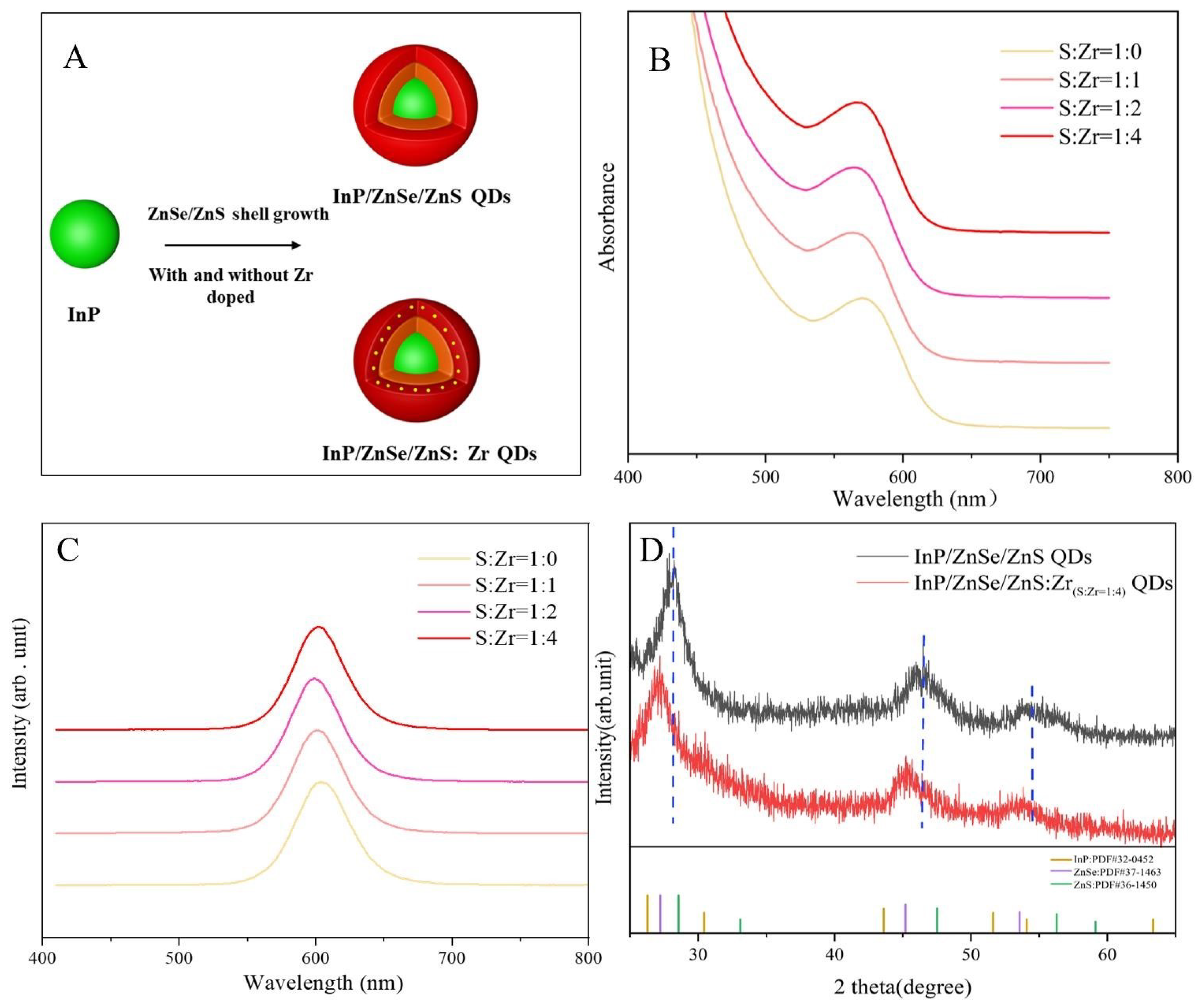
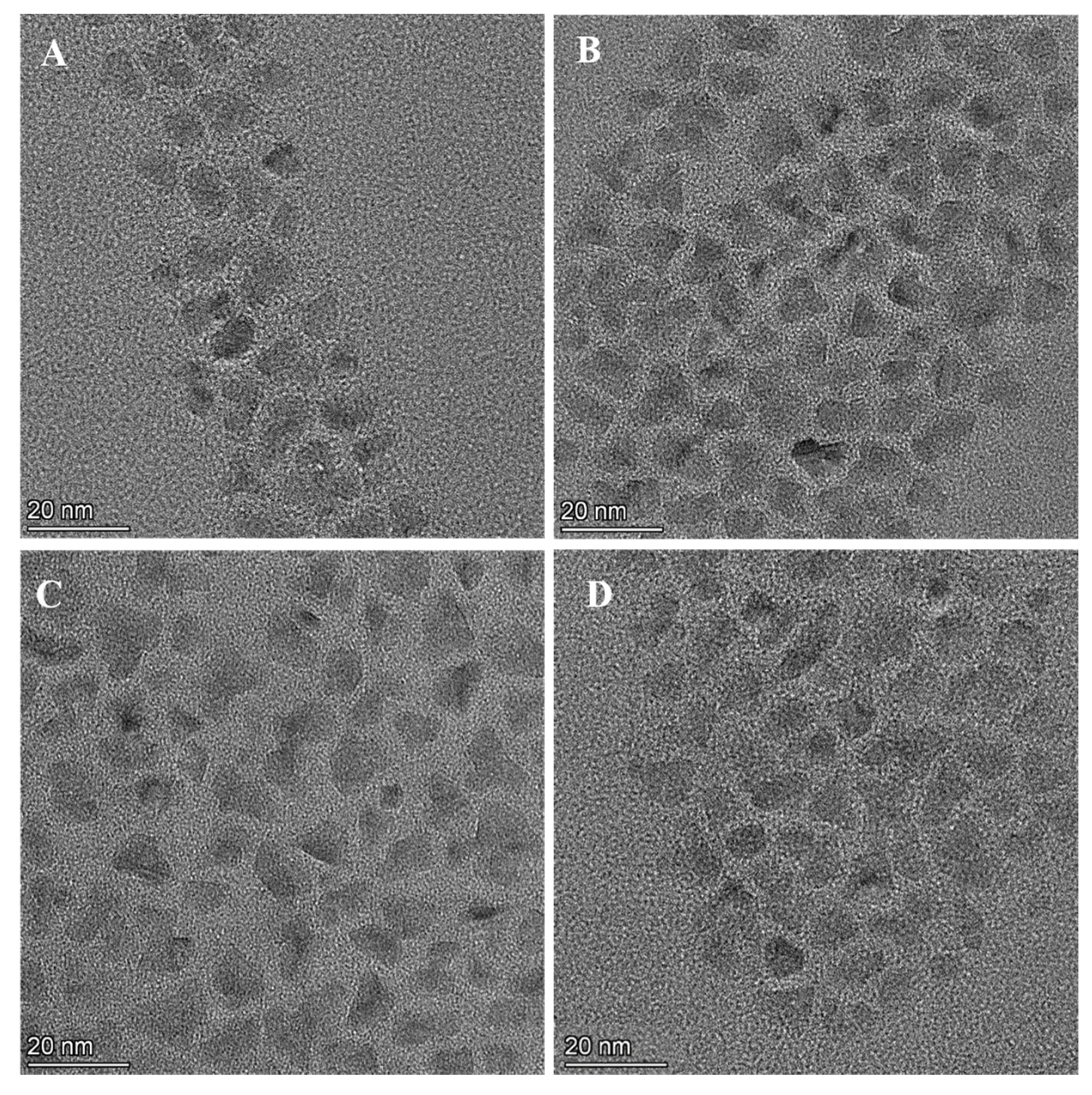
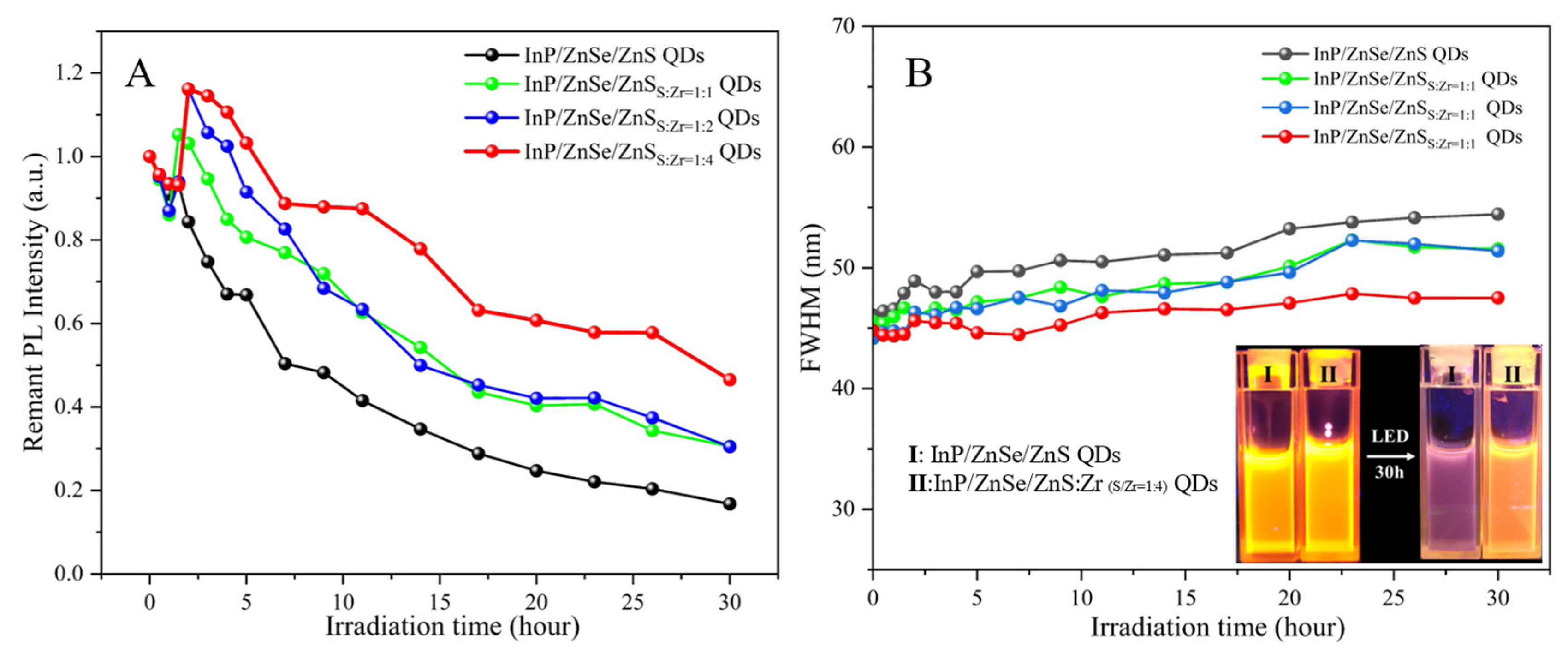
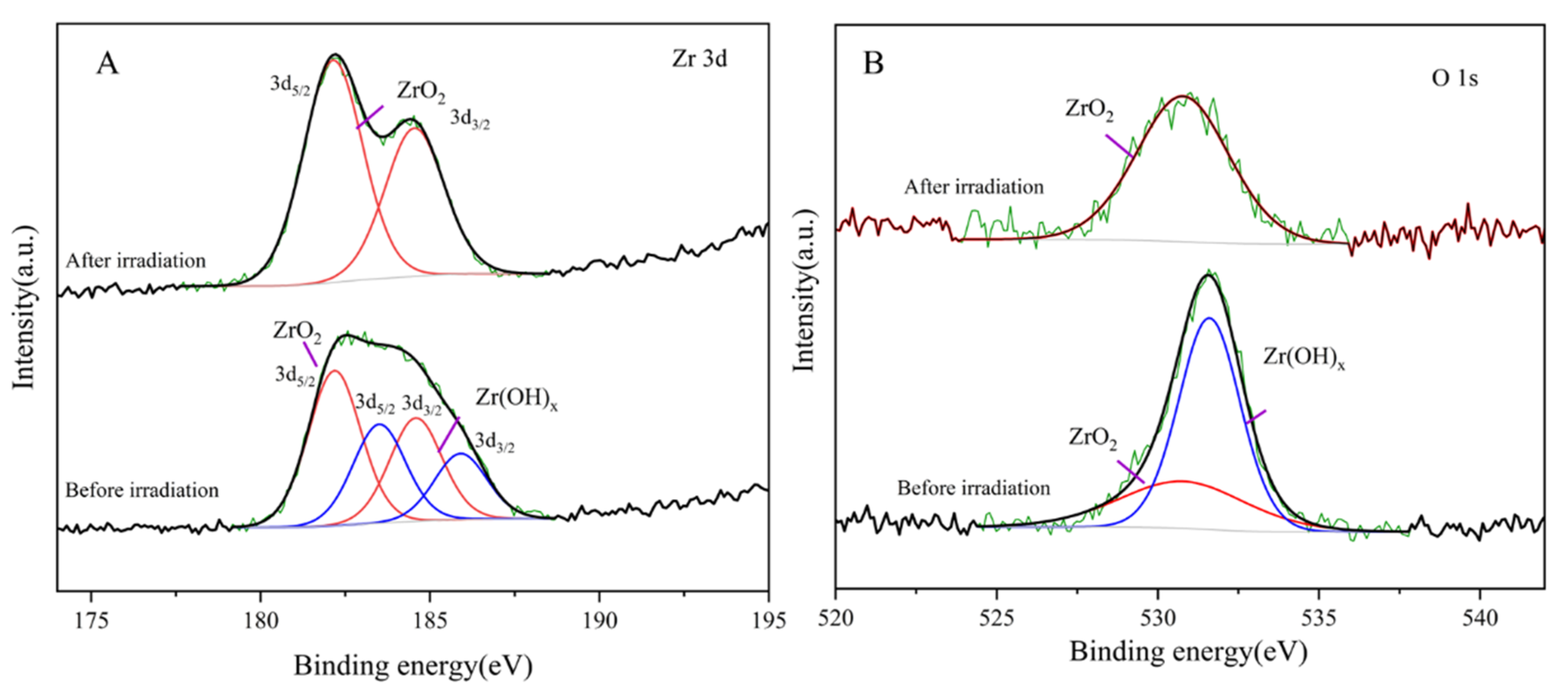
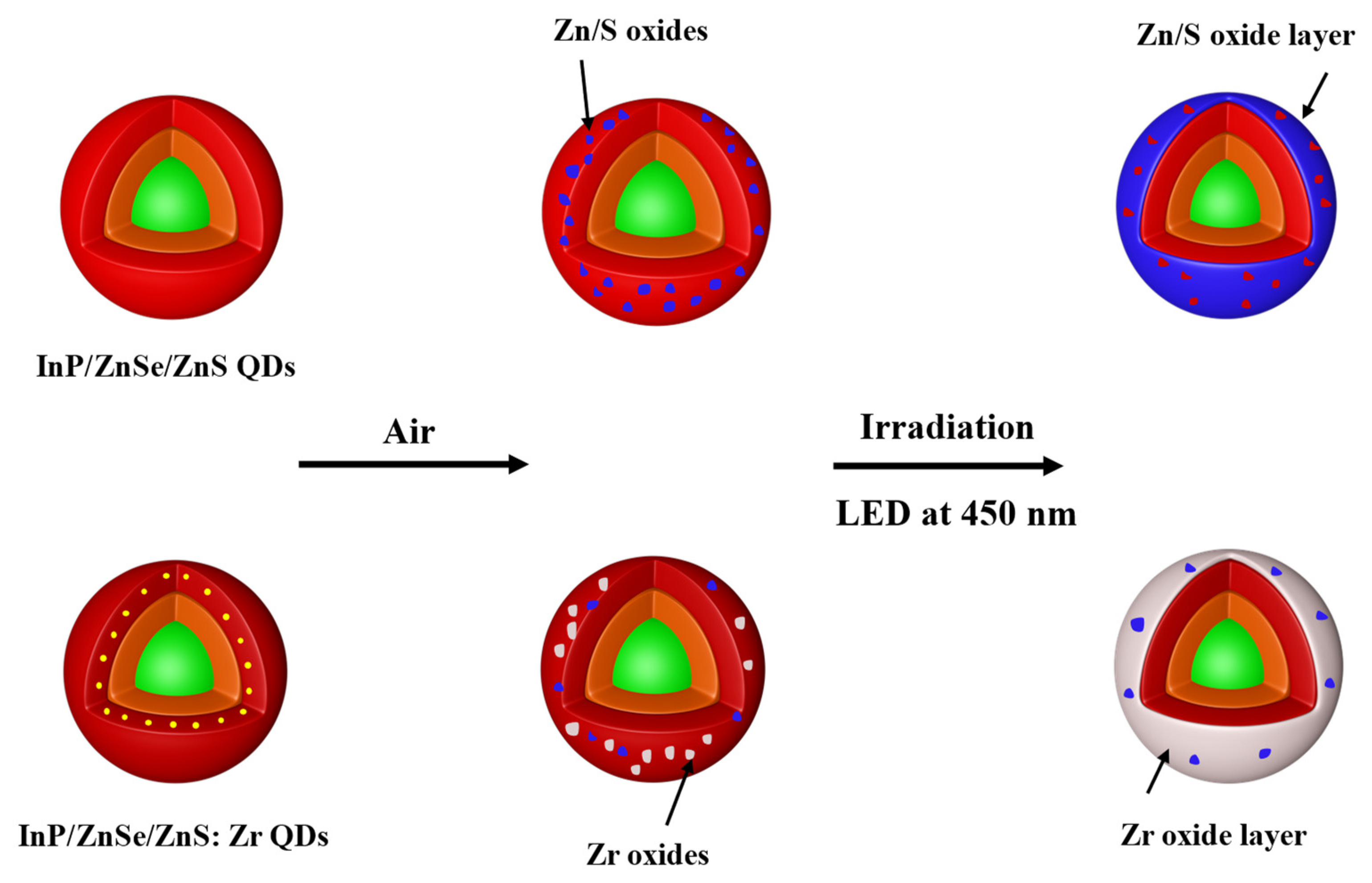
Publisher’s Note: MDPI stays neutral with regard to jurisdictional claims in published maps and institutional affiliations. |
© 2022 by the authors. Licensee MDPI, Basel, Switzerland. This article is an open access article distributed under the terms and conditions of the Creative Commons Attribution (CC BY) license (https://creativecommons.org/licenses/by/4.0/).
Share and Cite
Cheng, X.; Liu, M.; Zhang, Q.; He, M.; Liao, X.; Wan, Q.; Zhan, W.; Kong, L.; Li, L. A Novel Strategy to Enhance the Photostability of InP/ZnSe/ZnS Quantum Dots with Zr Doping. Nanomaterials 2022, 12, 4044. https://doi.org/10.3390/nano12224044
Cheng X, Liu M, Zhang Q, He M, Liao X, Wan Q, Zhan W, Kong L, Li L. A Novel Strategy to Enhance the Photostability of InP/ZnSe/ZnS Quantum Dots with Zr Doping. Nanomaterials. 2022; 12(22):4044. https://doi.org/10.3390/nano12224044
Chicago/Turabian StyleCheng, Xunqiang, Mingming Liu, Qinggang Zhang, Mengda He, Xinrong Liao, Qun Wan, Wenji Zhan, Long Kong, and Liang Li. 2022. "A Novel Strategy to Enhance the Photostability of InP/ZnSe/ZnS Quantum Dots with Zr Doping" Nanomaterials 12, no. 22: 4044. https://doi.org/10.3390/nano12224044
APA StyleCheng, X., Liu, M., Zhang, Q., He, M., Liao, X., Wan, Q., Zhan, W., Kong, L., & Li, L. (2022). A Novel Strategy to Enhance the Photostability of InP/ZnSe/ZnS Quantum Dots with Zr Doping. Nanomaterials, 12(22), 4044. https://doi.org/10.3390/nano12224044







